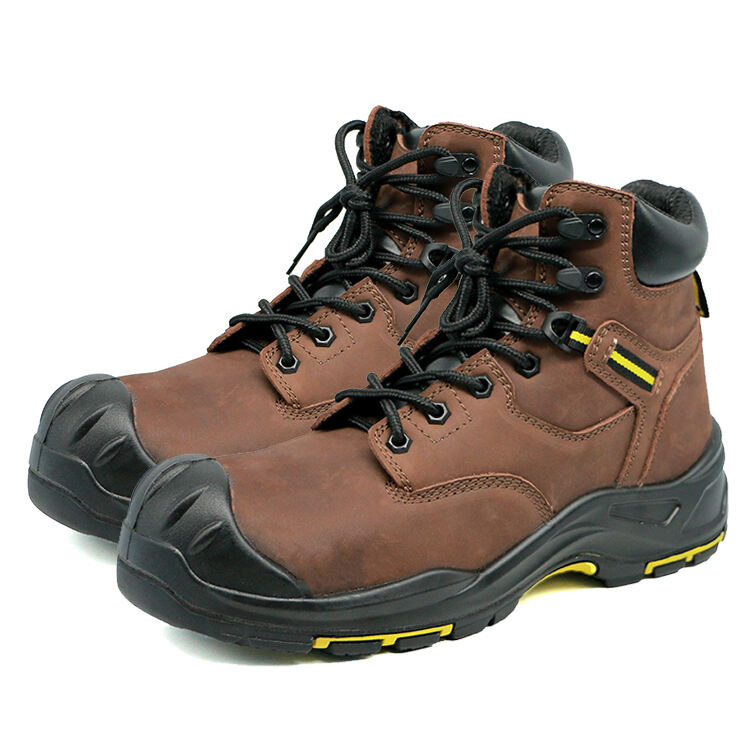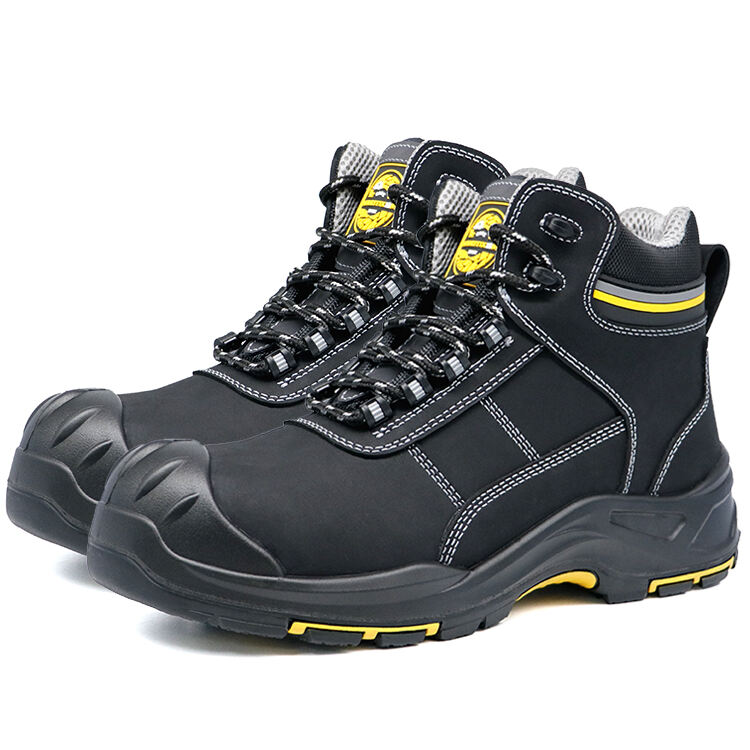
Choosing the Right Safety Footwear for Specific Industries
Industry-Specific Safety Footwear Requirements
Construction: Steel Toe Work Boots for Men
Steel toe work boots are indispensable in construction, providing crucial protection against potential hazards such as heavy falling objects or equipment. The role of steel toe boots goes beyond mere safety; these boots are crafted from durable materials that resist wear and tear, integrate shock-absorbing technology, and often meet higher safety standards like the ASTM F2413. These characteristics are vital given the high incidence of foot injuries in construction settings. In fact, data highlights how foot injuries in this sector are prevalent, with appropriate safety footwear significantly mitigating risks.
Explore a range of steel toe work boots here.
Manufacturing: Waterproof Steel Toe Boots
In manufacturing environments, where spills and wet conditions are common, waterproof steel toe boots become essential in preventing moisture-related injuries and ensuring worker comfort. Not only do these boots offer protection from wet surfaces, but they also incorporate designs that enhance durability through advanced waterproof materials, prolonging the life and effectiveness of safety footwear in challenging conditions. Industry experts acknowledge that waterproofing enhances the resilience, ensuring that footwear remains impermeable and sustainable under industrial stress, thereby safeguarding workers' feet effectively.
Check options for waterproof steel toe boots here.
Oil & Gas: Non-Slip Safety Shoes with Chemical Resistance
Working in the oil and gas industry demands robust non-slip safety footwear due to the risky nature of the environment, where slip-and-fall accidents are frequent. Non-slip safety shoes are equipped with chemical resistance features to protect against hazardous substances, complying with stringent industry standards to ensure the utmost safety. Statistics reveal how non-slip soles are instrumental in reducing workplace accidents, with studies showing a significant decrease in slip-related injuries, highlighting the importance of incorporating these shoes into standard PPE protocols.
Discover non-slip safety shoes suitable for oil and gas work here.
Healthcare: Lightweight Slip-Resistant Footwear
In the fast-paced healthcare industry, lightweight slip-resistant footwear plays a critical role in preventing slip-and-fall incidents while ensuring comfort for workers who are often on their feet for extensive periods. These shoes are designed for enhanced mobility, incorporating materials that prioritize both safety and comfort, such as cushioned insoles and breathable fabrics. Research in healthcare settings has shown a correlation between the use of proper footwear and reduced rates of workplace injuries, affirming the necessity of slip-resistant designs for healthcare professionals to maintain safe working environments.
Explore lightweight slip-resistant footwear for healthcare here.
Assessing Workplace Hazards for Optimal Foot Protection
Impact Risks: Falling Objects & Compression
In various industries, impact risks from falling objects and compression are a significant concern, necessitating protective footwear. Steel toe work boots, for instance, are designed with reinforced toe caps that provide essential protection against heavy machinery, falling tools, and other sources of impact. Such features are crucial in construction, manufacturing, and warehousing environments where heavy objects often pose threats. According to the Bureau of Labor Statistics, there were 44,970 non-fatal workplace foot injuries and illnesses reported in 2020, highlighting the critical need for appropriate footwear to prevent such injuries. Hence, investing in quality safety footwear like steel toe boots is vital in reducing the risk of foot injuries substantially.
Puncture Threats: Sharp Debris & Nails
The prevalence of sharp debris and nails on construction and industrial work sites elevates the risk of puncture wounds, making puncture-resistant footwear indispensable. These risks are mitigated by using footwear equipped with puncture-resistant soles, which significantly reduce the likelihood of injuries. In workplaces where nails, sharp glass, and other pointed objects are common, shoes with such protective features can prevent debilitating foot injuries that affect worker productivity. Data from various labor safety organizations reveal that puncture wounds remain a frequent hazard, particularly in the construction sector, underscoring the importance of adopting footwear solutions specifically designed to offer such protection.
Slip and Fall Prevention in Wet Environments
Slip and fall incidents are frequent in environments with wet surfaces, making the choice of footwear with slip-resistant features critical. Industries like food service, healthcare, and manufacturing often face such environmental factors, where spills and wet floors are routine. Safety footwear with slip-resistant soles, designed to enhance grip, can drastically reduce accident rates in these settings. Studies have demonstrated a marked reduction in slip-related accidents in workplaces that enforce the use of proper footwear, emphasizing the effectiveness of such safety measures. This highlights the importance of selecting protective footwear that caters to specific environmental risks to maintain workplace safety.
Understanding Safety Footwear Standards and Certifications
CSA Z195:14 Compliance for Canadian Industries
The CSA Z195:14 standards are vital for several Canadian industries, ensuring workers have adequate foot protection. These standards outline various requirements for impact resistance, metatarsal protection, electrical hazard protection, and sole puncture resistance, catering to specific industry needs. Compliance significantly influences footwear design and performance, aiming to reduce workplace injuries and enhance worker safety. Statistics underscore the importance of certified safety footwear, demonstrating a marked reduction in injuries when workers wear compliant boots, thus emphasizing the role of standards in mitigating risks.
ASTM F2413: U.S. Safety Shoe Requirements
ASTM F2413 standards in the U.S. specify safety footwear requirements to maintain workplace safety across diverse industries. The document outlines performance criteria such as impact resistance, compression resistance, puncture resistance, and electrical hazard protection, ensuring a comprehensive safety protocol. Various categories, like those with steel toe, offer specific protections tailored to workplace needs. Studies showcase the effectiveness of these standards in reducing injury rates, reflecting a positive impact on worker safety across different sectors.
Electric Shock Resistance in Hazardous Settings
Electric shock resistance in safety footwear is crucial for workers exposed to electrical hazards, safeguarding them against potentially lethal currents. The materials and designs compliant with these standards, like CSA and ASTM, ensure workers’ safety in environments with live currents. Safety footwear can mitigate risks associated with electrical exposure, exemplified by occupational health studies that confirm the effectiveness of shock-resistant boots in preventing injuries, thereby contributing to overall workplace safety and risk reduction.
Sizing Guidelines for Men's Steel Toe Work Boots
Proper sizing in men's steel toe work boots is critical for overall foot protection and comfort. Ill-fitting shoes can cause more than discomfort; they jeopardize safety by failing to provide adequate protection during workplace incidents. Incorrectly sized boots may lead to foot injuries by not distributing weight evenly or may cause blisters, foot pain, and long-term issues like calluses or bunions. This highlights the importance of getting the right fit based on thorough measurement and trial when selecting work boots.
Common issues from incorrect sizing include cramped toes, excessive heel movement, and uneven pressure, affecting both productivity and safety. Professional guidelines and reviews emphasize that an accurate fit in safety footwear is a crucial aspect of PPE in protecting workers from on-the-job injuries. The relevance of this is strongly supported by NIOSH, which states that poorly fitting PPE, such as oversized or undersized work boots, can create additional hazards instead of preventing them. Hence, adhering to proper sizing guidelines significantly enhances both comfort and safety in the workplace.
Arch Support and Breathability Features
Having adequate arch support is essential for minimizing foot fatigue and enhancing the comfort of workers during long shifts. Proper arch support helps in maintaining foot stability, distributing pressure evenly across the foot, and reducing the risk of developing conditions like plantar fasciitis. Additionally, it can enhance overall comfort for workers who spend long hours on their feet, thereby improving their efficiency and well-being in demanding work environments.
Breathability in materials plays a pivotal role in maintaining foot health and preventing discomfort. Footwear crafted with breathable materials allows for effective ventilation, reduces sweat accumulation, and keeps feet dry, which is crucial in preventing fungal infections and other foot-related problems. Health experts, such as those working with the CDC, recognize these features as vital in ensuring worker comfort and health, pointing out that poor quality and discomfort in PPE can lead to decreased compliance, as workers are less likely to use or keep on uncomfortable PPE.
Addressing Foot Fatigue in Long Shifts
Foot fatigue is a common challenge among workers in demanding environments, often resulting from standing for extended hours and insufficient footwear support. This fatigue can lead to decreased work performance and even more serious musculoskeletal issues over time. The selection of appropriate safety footwear can alleviate foot fatigue through features such as cushioning, ergonomic designs, and proper size fit.
Footwear innovations like cushioned insoles and ergonomic designs aim to provide added comfort and reduce strain on the feet. Case studies have shown a notable reduction in foot fatigue among workers wearing safety shoes designed with these ergonomic principles, demonstrating the effectiveness of such technologies. Cognitive researchers and occupational health studies affirm that when safety footwear meets ergonomic standards, it significantly enhances not just comfort but also the safety and productivity of the workplace, preventing injuries due to tiredness and lack of concentration.
Maintenance and Replacement of Safety Footwear
Cleaning Waterproof Steel Toe Boots
Cleaning waterproof steel toe boots is essential in maintaining their integrity and functionality. Regular cleaning methods include removing stubborn dirt with a soft brush and using mild soap with lukewarm water to wipe away grime. It's crucial to avoid harsh chemicals that might degrade waterproof membranes. Regular maintenance prolongs the lifespan of your boots, ensuring they continue to offer protection. According to several manufacturers, well-maintained safety footwear can last significantly longer than neglected ones, maintaining both safety and comfort for extended periods.
Signs of Wear: Sole Damage & Toe Cap Integrity
Identifying signs of wear in safety footwear is crucial for maintaining safety standards. Pay attention to worn-out soles, as reduced grip can lead to slips, and check toe caps for any dents or cracks that could compromise foot protection. Ignoring these signs can decrease worker safety and productivity, leading to potential workplace accidents. Regular inspections of safety footwear, as advocated by safety guidelines, can prevent these accidents, ensuring the footwear continues to serve its protective function efficiently.
When to Retire Non-Slip Safety Shoes
Knowing when to retire non-slip safety shoes is critical for preventing workplace accidents. Factors such as sole thinning, reduced slip resistance, and signs of material degradation indicate it's time for replacement. Continued use of worn-out footwear increases the risk of slips and falls. Statistics from safety organizations reveal that outdated or damaged footwear contributes significantly to workplace injuries. Ensuring footwear is replaced when necessary helps maintain a safe working environment and protects the well-being of all personnel.

 EN
EN
 AR
AR BG
BG HR
HR CS
CS DA
DA NL
NL FI
FI FR
FR DE
DE EL
EL HI
HI IT
IT JA
JA KO
KO NO
NO PL
PL RO
RO RU
RU ES
ES SV
SV TL
TL ID
ID SR
SR VI
VI HU
HU MT
MT TH
TH TR
TR AF
AF MS
MS GA
GA BN
BN NE
NE
